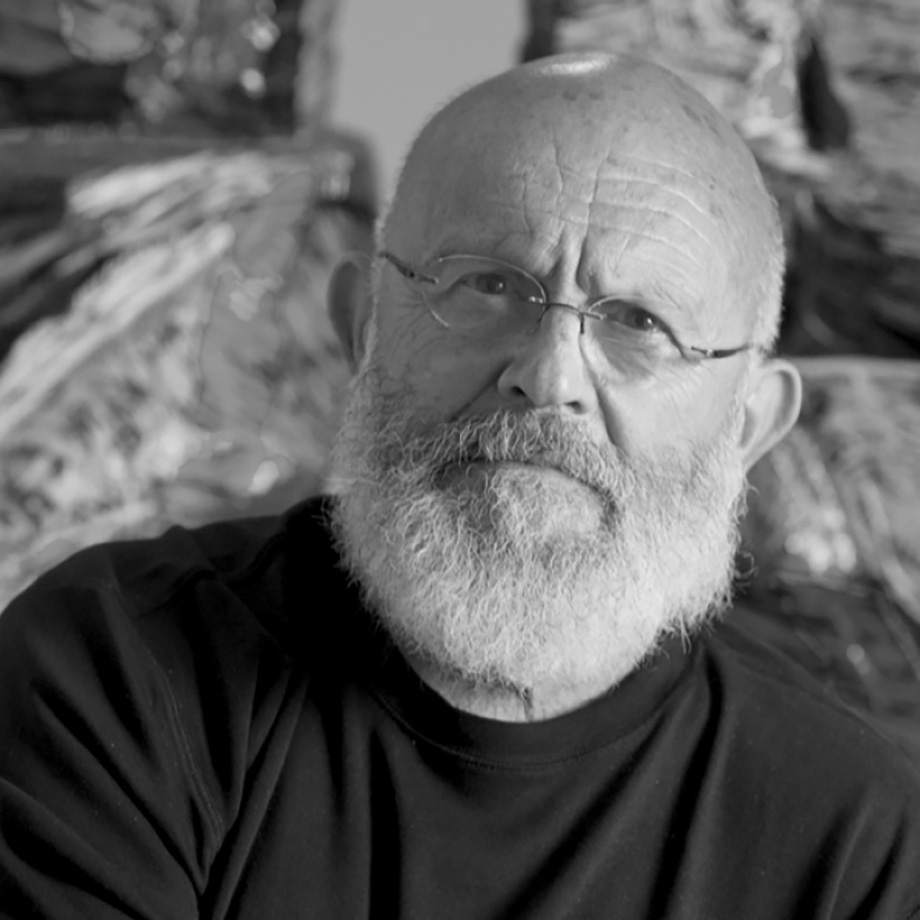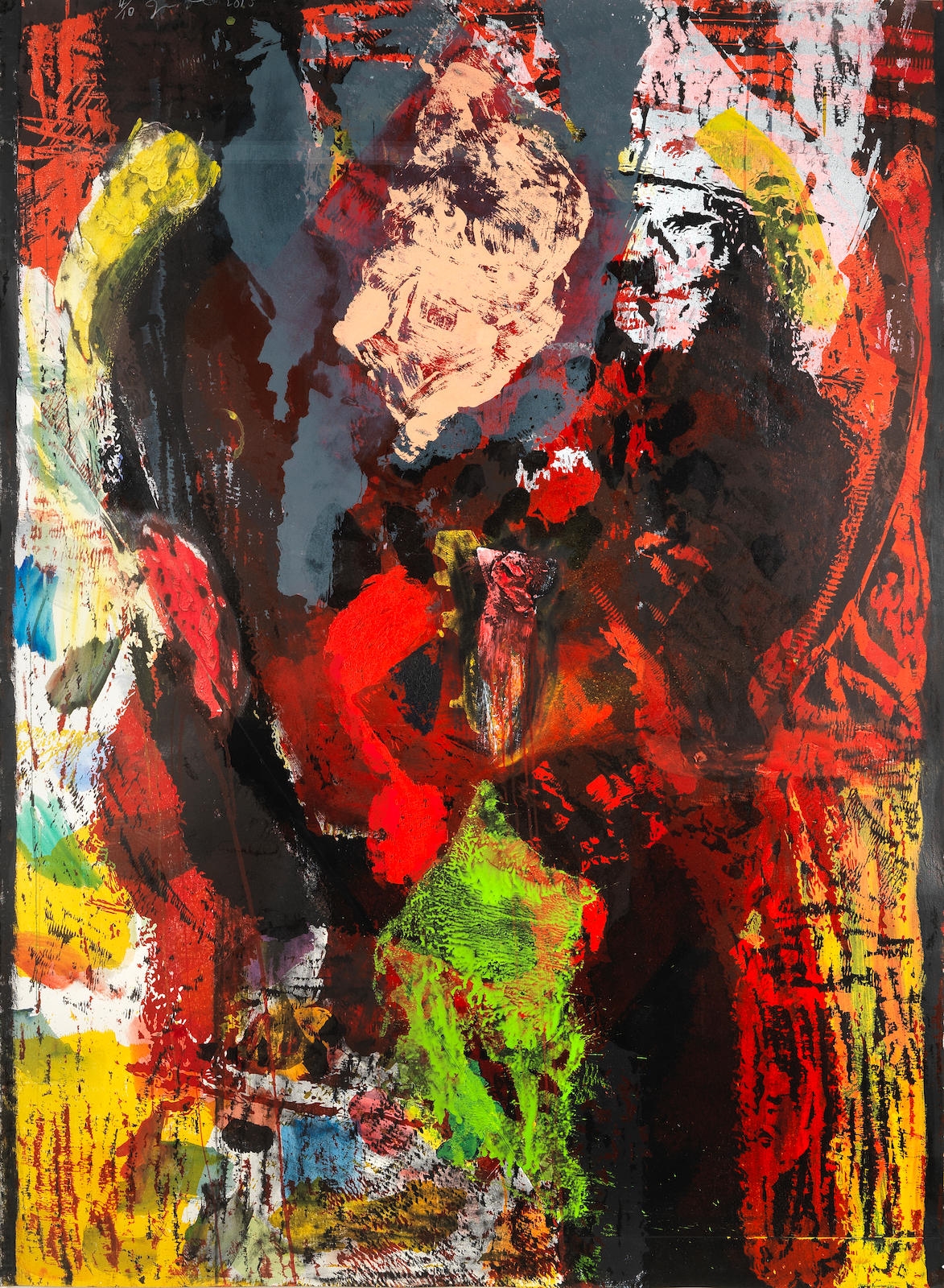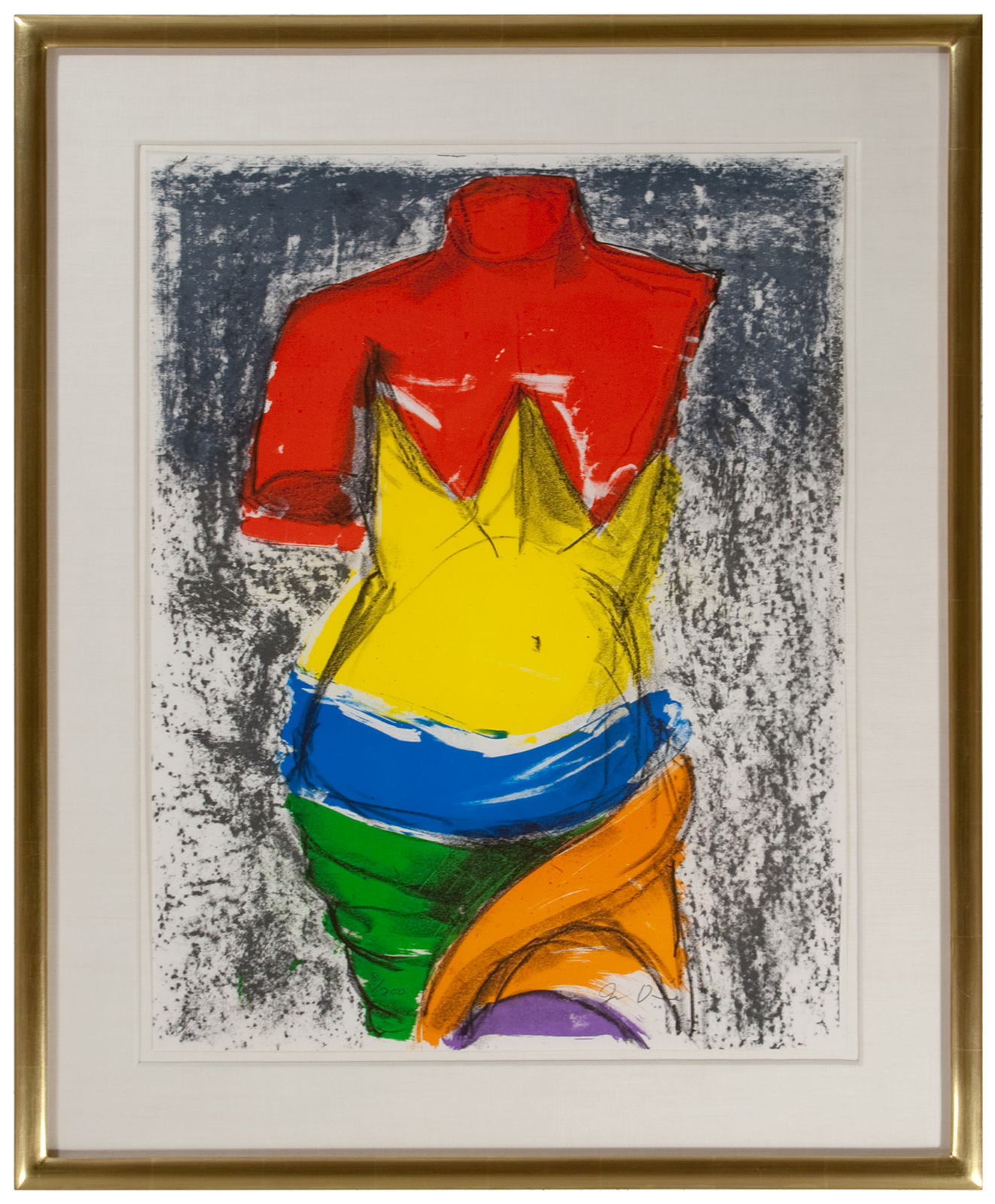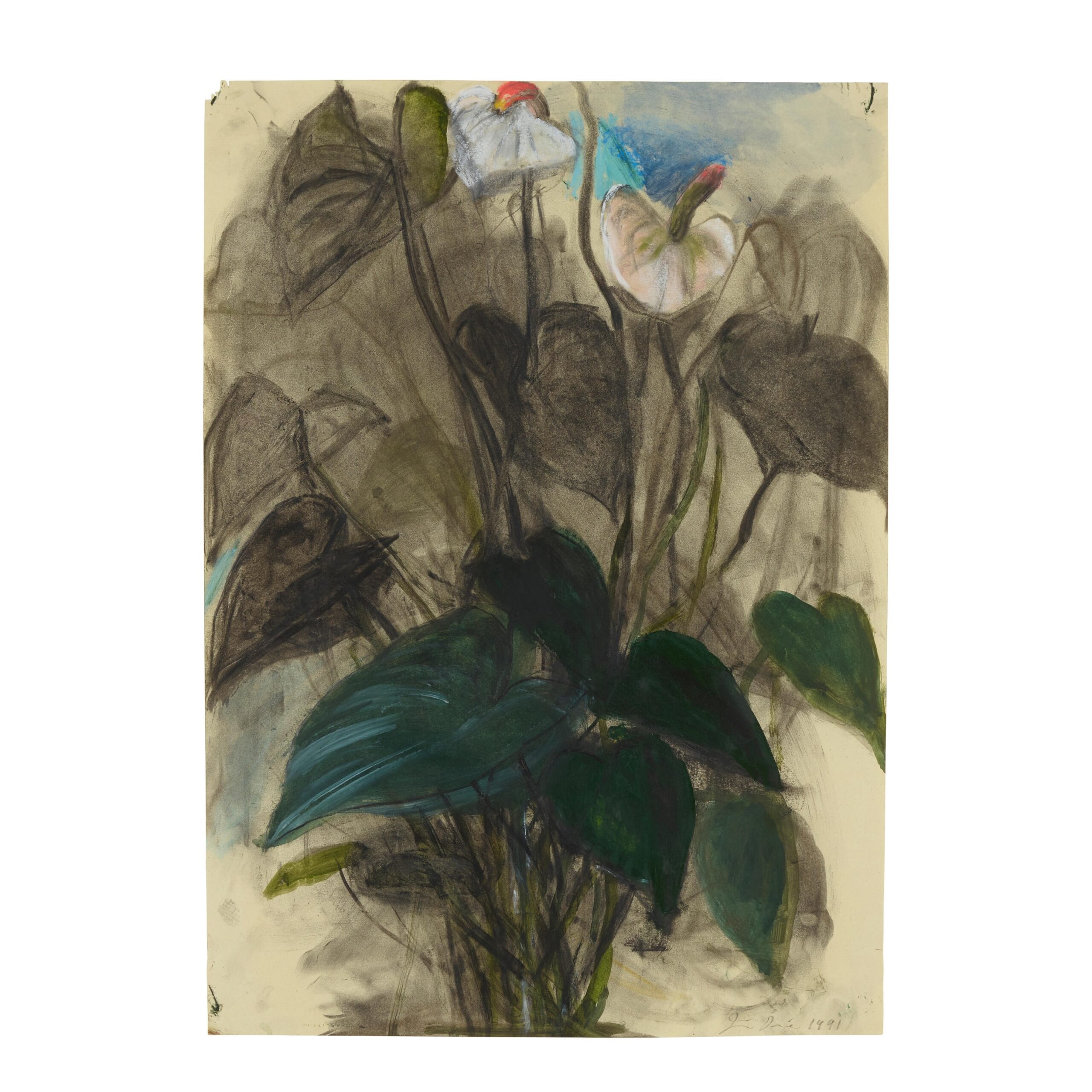
Jim Dine
“The figure is still the only thing I have faith in in terms of how much emotion it’s charged with and how much subject matter is there,” he once said.
Jim Dine
Biography
Although often associated with both Pop Art and Abstract Expressionism, Jim Dine did not identify with a specific movement, producing a vast oeuvre of paintings, drawings, works on paper, sculpture, poetry, and performances. Emerging as a pioneer (together with Allan Kaprow, Claes Oldenburg, and Robert Whitman) of New York’s Happenings of the 1960s, Dine would carry the spontaneous energy of this movement throughout his style, which emphasized the exploration of everyday life. Personally significant objects were Dine’s primary motifs, as in his iconic series of hearts and robes. He championed a return to figuration after a period of more concept-dominated works, and is considered an important figure in Neo-Dada and a forerunner of Neo-Expressionism. “The figure is still the only thing I have faith in in terms of how much emotion it’s charged with and how much subject matter is there,” he once said.
935 – Born in Cincinnati, Ohio
1953-1955 – Studied at the University of Cincinnati and Boston Museum School
1957 – BFA Ohio University, Athens, Ohio
1958 – Graduate study at Ohio University, Athens, Ohio
Exhibitions
2016
Jim Dine: About the Love of Printing, Museum Folkwang, Essen, Germany
2015
Jim Dine: A Life in Printmaking, Washington State University Museum of Art, St. Louis, Missouri
Jim Dine: People, Places, Things, Brattleboro Museum and Art Center, Brattleboro, Vermont
Jim Dine: Hearts of Stone, Wetterling Gallery, Stockholm, Sweden
Jim Dine: City of Glass, Galerie Daniel Templon, Paris, France
Jim Dine: 80, Alan Avery Art Company, Atlanta, Georgia
Jim Dine: My Tools, Die Photographische Summlung / SK Stiftung Kultur, Cologne, Germany [cat.]
Jim Dine: A Retrospective, Jonathan Novak Contemporary Art, Los Angeles, California
2014
Jim Dine: A History of Communism and Jim Dine: Printmaker, Alan Cristea Gallery, London [cat.]
Jim Dine: New Paintings, Galerie Daniel Templon, Paris, France
Jim Dine: Skulls, 1982-2000, Chazen Museum of Art, University of Wisconsin-Madison, Madison, Wisconsin
2013
Jim Dine: Pace Gallery, New York, New York [cat.]
2012
Jim Dine: Galerie Daniel Templon, Paris, France
Jim Dine: Nassau County Museum of Art, Roslyn Harbor, New York
2011
Jim Dine: Frederik Meijer Gardens and Sculpture Park, Grand Rapids, Michigan
Jim Dine: Recent Editions, Pace Prints, New York, New York
Jim Dine: Pace Gallery, New York, New York [cat.]
Jim Dine: Agnellini Arte Moderna, Brescia, Italy
Jim Dine: Theme and Variation: A Half Century of Printmaking, Nagoya/Boston Museum of Fine Arts, Nagoya, Japan
Jim Dine: The Glyptotek Drawings, Morgan Library and Museum, New York, New York [cat.]
Jim Dine: Galerie de Bellefeuille, Montreal, Canada
Jim Dine: Work That Sings, Leeahn Gallery, Daegu, Korea
2010
Jim Dine: Hearts from New York, Göttingen, and New Delhi, Alan Cristea Gallery, London, United Kingdom [cat.]
Jim Dine: William Shearburn Gallery, San Francisco, California
Jim Dine: The Wind and Tools (A Glossary of Terms), 2009, Murphy and Dine Gallery Wainscott, Wainscott, New York
2009
Jim Dine: Old Me Now – Self Portrait Drawings 2008-2009, Richard Gray Gallery, Chicago, Illinois [cat.]
Jim Dine: Göttingen Songs, Galerie Daniel Templon, Paris, France
Jim Dine: Thordén Wetterling Gallery, Gothenburg, Sweden
Jim Dine: A Walk on the Beach, Pace Wildenstein, New York, New York
Jim Dine: A Walk in the Park: Outdoor Sculpture at Pace Wildenstein, Pace, New York, New York
2008
Jim Dine: Poet Singing (The Flowering Sheets), J. Paul Getty Museum, Getty Villa, Malibu, California
Jim Dine: Hot Dream – 52 Books, Museum Liner, Appenzell, Switzerland; traveled to Pace Wildenstein, New York, New York (2008) [cat.]
Jim Dine: Pinocchio Prints, Galerie Daniel Templon, Paris, France
2007
Jim Dine: Selected Prints, 1996-2006, Amie and Tony James Gallery, CUNY, New York, New York
Jim Dine: Light, Time and Three Dimensions, Pace, New York, New York
Jim Dine’s Pinocchio, New York Public Library, New York, New York
2006
Jim Dine: Botanical Drawings, Wildenstein & Company, New York, New York
Jim Dine: Large-scale sculpture inaugurating the newly renovated sculpture garden on the Armory’s campus, Armory Art Center, West Palm Beach, Florida
2005
Jim Dine: Pinocchio as I Knew Him, Richard Gray Gallery, Chicago, Illinois [cat.]
Jim Dine: Some Drawings, Allen Memorial Art Museum, Oberlin College, Oberlin, Ohio; traveled to the Neuberger Museum of Art, Purchase College, State University of New York (2005- 2006); Mary and Leigh Block Museum of Art, Northwestern University, Chicago, Illinois (2006); Frederick R. Weisman Museum of Art, Pepperdine University, Malibu, California (2007) [cat.]
2004
Jim Dine: Göttingen – Paris, Richard Gray Gallery, Chicago, Illinois [cat.]
Drawings of Jim Dine, National Gallery of Art, Washington, D.C. [cat.]
Jim Dine: Hearts, Tools, Portraits and Self-Portraits, PaceMacGill, New York, New York
Jim Dine: New Paintings, Photographs and a Sculpture, PaceWildenstein, New York, New York [cat.]
Jim Dine: New Photographs, Galerie Daniel Templon, Paris, France
Jim Dine: Sculpture from the Walla Walla Foundry, Museum of Art, Washington State University, Pullman, Washington
Jim Dine: Pace Prints, New York, New York
2003
Jim Dine: Photographs, so far, Maison Européene de la Photographie, Paris, France; traveled to Hasselblad Center at Goteborg Museum of Art, Goteborg, Sweden (2004); Die Photographische Summlung/SK Stiftung Kultur, Cologne, Germany (2004); Davison Art Center & Ezra and Cecile Zilkha Gallery, Wesleyan University, Middletown, Connecticut (2004); Cleveland Museum of Art, Cleveland, Ohio (2005) [cat.]
Jim Dine: Bentley Gallery, Scottsdale, Arizona
Jim Dine: Recent Paintings, John Berggruen Gallery, San Francisco, California
Jim Dine: Monoprints, Pace/Prints, New York, New York
Jim Dine: Wetterling Gallery, Stockholm, Sweden
Jim Dine: Paintings, Sculptures and Works on Paper, Shaheen Modern and Contemporary Art Gallery, Cleveland, Ohio
Jim Dine: New Tool Paintings, PaceWildenstein, New York, New York
2002
Jim Dine Prints: 1985–2000, Minneapolis Institute of Arts, Minneapolis, Minnesota [cat. raisonné]
Jim Dine: Printing and Dancing, 2002, Pace/Prints, New York, New York
Jim Dine: New Hand–Painted Monoprints, Alan Cristea Gallery, London, United Kingdom
2001
Jim Dine: Monuments to the Human Condition Sculpture + Paintings, Bentley Gallery, Scottsdale, Arizona [cat.]
Jim Dine: Galerie Daniel Templon, Paris, France
Jim Dine: Wildenstein, Tokyo, Japan
Jim Dine: D’apres l’Antique, Musée du Louvre, Paris, France
2000
Jim Dine: Galerie Daniel Templon, Paris, France
Jim Dine: Gasiunasen Gallery, Palm Beach, Florida
Jim Dine: Recent Work, Wetterling Gallery, Stockholm, Sweden
1999
Jim Dine: Walking Memory, 1959–1969, Solomon R. Guggenheim Museum, New York, New York; travelled to Cincinnati Art Museum, Cincinnati, Ohio (2000) [cat.]
Jim Dine: New Color Photographs, Gerald Peters Gallery, Santa Fe, New Mexico
1998
Jim Dine: Galería Ramis Barquet, Monterrey, Mexico [cat.]
Jim Dine New Photographs: Kali in New York, PaceWildensteinMacGill, New York, New York
1997
Jim Dine: Ochi Gallery, Ketchum, Idaho
Jim Dine: Druckgraphik aus den Jahren 1987–1996, Galerie im Traklhaus, Salzburg, Germany
1996
Jim Dine: The Body and its Metaphors, organized by Art Life Ltd., Tokyo, Japan; traveled to Miyagi Prefectural Museum, Miyagi (1996); Museum of Contemporary Art, Sapporo, Hokkaido (1996-1997); Marugame Genichiro-Inokuma Museum of Contemporary Art, Kagawa, Japan (1997); Koriyama City Museum of Art, Fukushima, Japan (1997); and Gifu Prefectural Museum, Gifu, Japan (1997) [cat.]
Jim Dine: The Iconic Object, Savannah College of Art and Design, Savannah, Georgia; traveled to Heath Gallery, Inc., Atlanta, Georgia as Jim Dine: Icons of One (1996) [cat.]
1995
Jim Dine: Major Icon Paintings and Sculptures, Arij Gasiunasen Fine Art Inc., Palm Beach, Florida
Jim Dine: International Exhibition Centre, Helsinki, Finland
1994
Jim Dine: Walldrawing, Kunstverein Ludwigsburg, Ludwigsburg, Germany
Jim Dine: Flowers and Plants, Pace Drawings, New York, New York [cat.]
Jim Dine: Paintings, Drawings and Sculpture 1973–1993, Borås Konstmuseum, Borås, Sweden; traveled to Ludwig Museum, Budapest, Hungary (1994); Musée d’Art Moderne et d’Art Contemporain, Nice, France (1994) [cat.]
1993
Jim Dine: Drawing from the Glyptothek, Madison Art Center, Madison, Wisconsin; travelled to Cincinnati Art Museum, Cincinnati, Ohio (1994); Contemporary Museum, Honolulu, Hawaii, (1994); Montreal Museum of Fine Arts, Montreal, Canada, (1994) [cat.]
Jim Dine: New Etching & Woodcuts, Pace Prints, New York, New York
1992
Jim Dine: Galerie Alice Pauli, Lausanne, Switzerland
Important Sculpture by Jim Dine, Avenue Galleries, Palm Beach, Florida
1991
Jim Dine: Trembling for Color, Galerie Beaubourg, Paris, France
Jim Dine: New Paintings and Sculpture, Pace Gallery, New York, New York [cat.]
1990
Jim Dine: retrospective exhibition, Isetan Museum, Tokyo, Japan; traveled to Museum of Art, Osaka, Japan (1991)
Jim Dine: Ten Hand Colored Winter Tools, 1973–1989, K. Kimpton Gallery, San Francisco, California
Videos
TateShots: Jim Dine
Jim Dine’s Poet Singing (The Flowering Sheets): A Documentary


